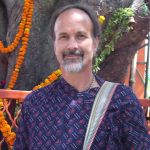David L. Haberman

David L. Haberman
Competition: US & Canada
Indiana University
I am a professor of Religious Studies at Indiana University, Bloomington, specializing in the Hindu religious traditions of India. After receiving a B.A. in Religious Studies from the University of Colorado in 1976 and a Ph.D. in History of Religions from the University of Chicago in 1984, I taught at the University of Arizona and Williams College before joining the faculty at Indiana University in 1993.
My interests include religion as a worldwide phenomenon and vital feature of human experience; I remain engaged in the study of ritual theory and practice and explorations of theoretical approaches to the study of religion, especially as regards that never-ending question: "What is religion?" Specifically, however, my research concentrates on the medieval and modern religious movements of northern India. Much of my work has focused on the culture of Braj, an active pilgrimage site known for its lively temple festivals, performative traditions, and literary creations. More recently I have included in my research interests the ancient city of Banaras, a pilgrimage center and temple town located on the bank of the Ganges River.
My scholarly approach combines textual research and anthropological fieldwork. My first book, Acting as a Way of Salvation: A Study of Raganuga Bhakti Sadhana (Oxford UP, 1988), is an investigation of religious reality construction based on a close examination of an aesthetically informed meditation technique devised by the theoreticians of Braj. I have published a book on the circular pilgrimage around Braj, entitled Journey Through the Twelve Forests: An Encounter with Krishna (Oxford, 1994), which won an American Academy of Religion Award for Excellence the year it came out. This book contemplates the complexities of circular wanderings and different strategies for dealing with the tumultuous nature of desire as I take the reader on a spatial and mythological journey. I completed an annotated translation of a sixteenth-century Sanskrit text, The Bhaktirasamrtasindhu of Rupa Gosvamin (Indira Gandhi National Centre for the Arts, 2003), which presents the religious experience of bhakti in terms of classical Indian dramatic theory.
My current passion is for the field of Religion and Ecology; I am involved in developing this emerging field and am currently on the Advisory Board of the Forum on Religion and Ecology based at the Yale University School for Forestry and Environmental Studies. As a student of the religious cultures of India, I am interested in investigating the effects that current environmental degradation is having on the traditional religious culture which views the immanent world of nature as permeated with divine presence; I am also interested in learning how this traditional theology is being employed by Indian environmental activists to resist environmental degradation. My book, River of Love in an Age of Pollution: The Yamuna River of Northern India (University of California Press, 2006), is a study of the Yamuna River, which for centuries has been worshiped as a goddess. In this book I explore various conceptions of this aquatic goddess with texts stretching back over a period of three millennia as well as through ethnographic research at a number of temples located on the banks of the river, examining how the current pollution of the river is affecting the religious culture associated with it, and track the manner in which the religious communities associated with the river are marshaling their religious resources to fight the pollution of the river. My last book, People Trees: Worship of Trees in Northern India (Oxford, 2013), explores the conceptions of trees in the context of the tree shrines of northern India while reexamining such concepts as animism and anthropomorphism.
I am now preparing to engage in research that speaks to my youth as a Colorado mountain boy. The Guggenhein Fellowship will allow me to work on a book project, tentatively entitled “Loving Stones: Worship of Mount Govardhan.” Mount Govardhan is the most distinguishing feature of the sacred landscape of Braj, the region in northern India associated primarily with Krishna. The entire hill, as well as every stone from it, is regarded as a sentient form of divinity that humans can approach for a variety of religious interactions and beneficial relationships. This idea stretches the boundary of the dominant social reality within North American culture to a breaking point; it is simply impossible to have a relationship with a rock. In addition to investigating the religious conceptions and practices associated with Mount Govardhan, my challenge is to explore interpretive strategies for making the impossible possible. This will lead me deep into theoretical considerations of incongruity, inconceivability, and like realms of the impossible. In other words, my aim is to use the worship of Mount Govardhan as a site to explore ways in which scholars who are engaged in the difficult work of representing other cultures struggle with radical incongruity, and to use this site as a springboard into theoretical reflection on the work of translating something as challenging as rock worship, often vilified with the heavily loaded religious label “idolatry” and disparaged with the psychological pronouncement “absurd” or “mad.”